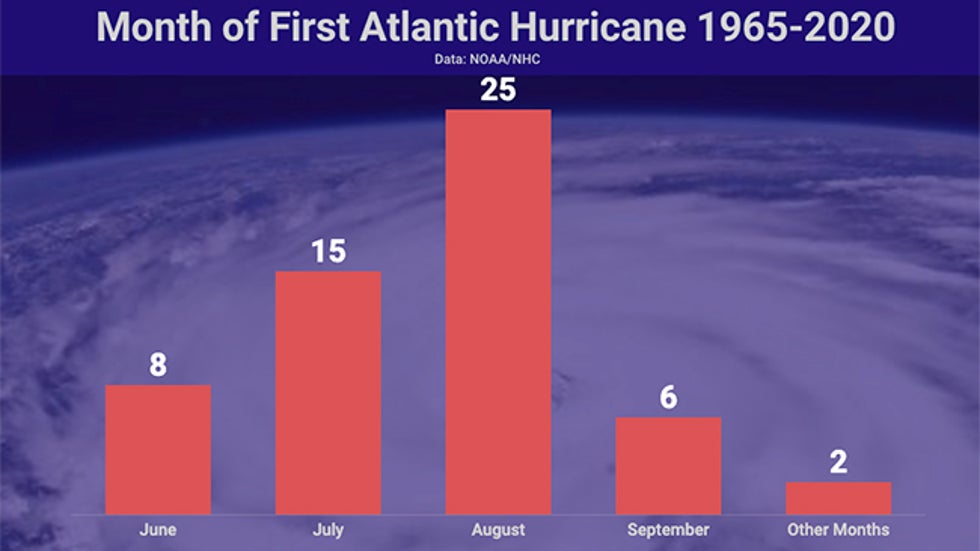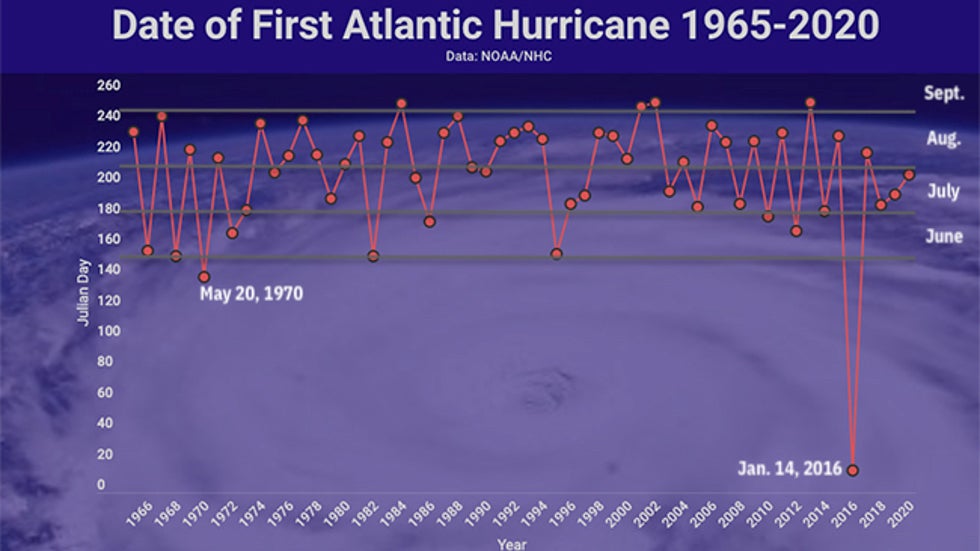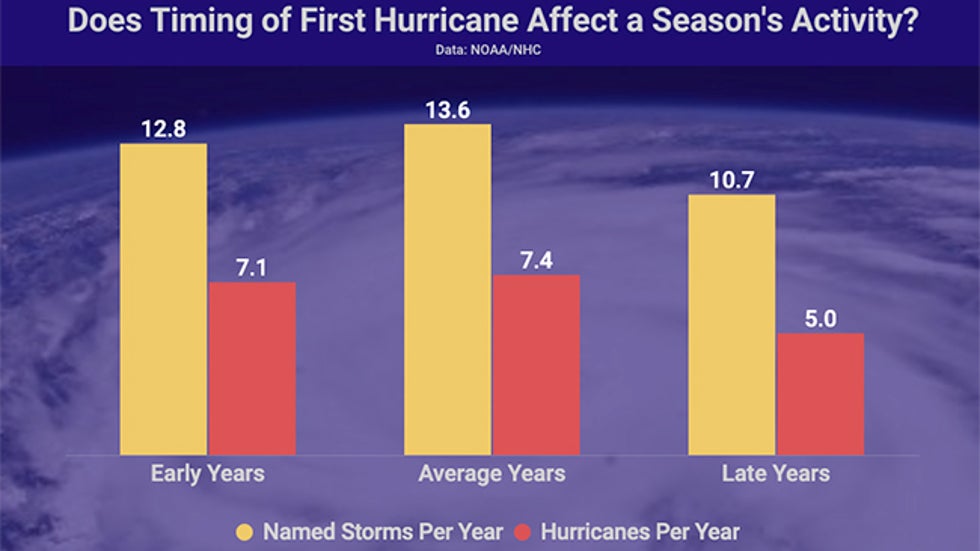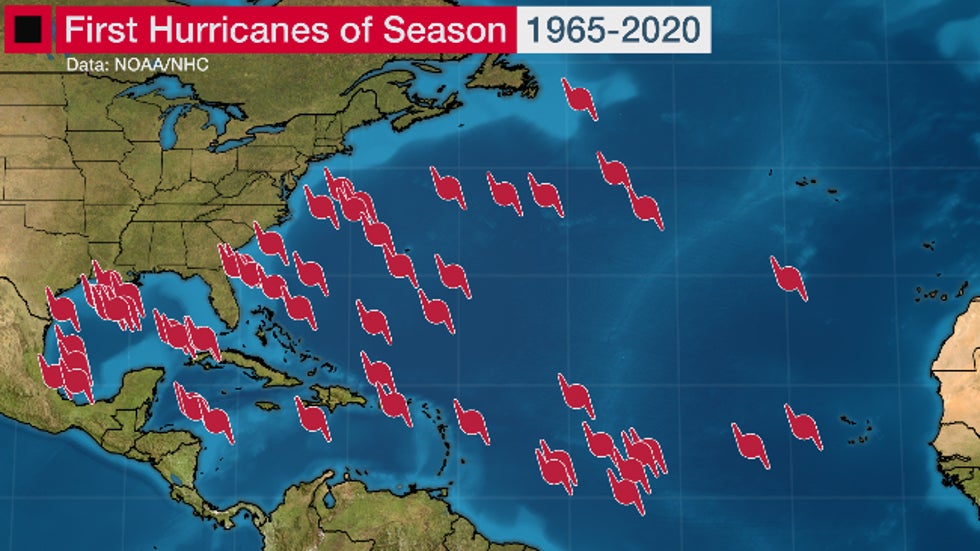Jonathan Erdman
The Atlantic hurricane season officially begins June 1, but it's usually a while until the season's first hurricane forms.
However, that hasn't been the case recently with the season's first tropical or subtropical storm.
When Ana formed east of Bermuda on May 22, 2021, it became the seventh year in a row with at least one named storm before the official June 1 kickoff of the season.
Last year, Hanna became the first hurricane of the record-smashing 2020 season on July 25 in the Gulf of Mexico just before it made landfall along the South Texas coast.
But how typical is it to wait almost two months into hurricane season before the first hurricane develops?
To answer that, we looked at data from the mid-1960s – when full satellite coverage of the Atlantic Basin began – through 2020 to see how variable the date of the season's first hurricane has been. We also examined where those first hurricanes formed and whether early or late first hurricanes told us anything useful about the season as a whole.
Usually in July or August
In 40 of the 56 hurricane seasons since 1965, the first Atlantic hurricane of the season formed in either July or August.
 The number of times the first Atlantic hurricane season formed in each respective month from 1965-2020. Note, this corresponds to the date when the system first became a hurricane, not when it first became a tropical depression.
The number of times the first Atlantic hurricane season formed in each respective month from 1965-2020. Note, this corresponds to the date when the system first became a hurricane, not when it first became a tropical depression.This makes sense.
Very early in the season, wind shear that can disrupt or rip apart tropical cyclones is still at least modest. Areas of sinking, dust-laden air from the Sahara Desert push westward across the Atlantic, suppressing thunderstorms needed for tropical development.
Beginning in July, tropical waves – the disturbances often serving as the seeds of tropical storms and hurricanes – become more numerous migrating off the African coast. Wind shear diminishes toward its seasonal low, and ocean temperatures warm in the summer heat. All these are favorable factors that combine to support not simply tropical storms, but also hurricanes.
But There's Variability
Now let's look closer at the actual dates of the season's first hurricane over the last 56 years, plotted in the graph below.
They're plotted as Julian days – where Jan. 1 would be Julian day 1, Feb. 1 Julian day 32 and so on. We did this in order to calculate an average day you'd expect the first hurricane of the season to have formed by, which was July 27.
 Dates of the season's first Atlantic hurricane from 1965 through 2020, expressed as Julian days, where Jan. 1 is Julian day 1. Notable early outliers in 1970 and 2016 are labeled.
Dates of the season's first Atlantic hurricane from 1965 through 2020, expressed as Julian days, where Jan. 1 is Julian day 1. Notable early outliers in 1970 and 2016 are labeled.But as you can see, there's a lot of variability in this date.
In 1970, Alma briefly became a hurricane on May 20 between Jamaica and Honduras before it weakened to a tropical depression 36 hours later in the western Caribbean Sea.
In 2016, Hurricane Alex made a freakish mid-January appearance south of the Azores in the eastern Atlantic Ocean.
We've also had very long waits for the first hurricane, including several times this century.
The 2013 season's first hurricane didn't develop until Sept. 11 (Humberto). That was also the case in 2002, with Gustav.
Does Timing of the First Hurricane Relate to an Active Season?
You're probably wondering whether the timing of the first hurricane tells you anything about how active the season will be.
Since 1965, we found 14 seasons in which the first hurricane formed at least three weeks earlier than the July 27 average, 21 seasons in which it formed within three weeks of the average date, and another 21 seasons in which it formed at least three weeks later than average.
It turns out there's little difference in the total number of tropical storms and hurricanes in seasons that have an early first hurricane compared to those that have a near-average first hurricane date.
 Total number of storms (yellow bars) and hurricanes (red bars) that occurred in seasons with an early first hurricane (left), a near-average date of the first hurricane (middle bars) and a late-arriving first hurricane (right-most bars) from 1965 through 2020.
Total number of storms (yellow bars) and hurricanes (red bars) that occurred in seasons with an early first hurricane (left), a near-average date of the first hurricane (middle bars) and a late-arriving first hurricane (right-most bars) from 1965 through 2020.This makes sense.
Since the majority of a season's activity occurs during its late August through September peak, whether a storm manages to reach 75 mph winds in June or early July shouldn't matter for the overall season. One caveat to this, though, is the tendency for an early hurricane in the so-called main development region between the Lesser Antilles and west Africa to foreshadow an active season.
However, note there are about three fewer storms and two to three fewer hurricanes in seasons with a late-arriving first hurricane compared to average.
That's also logical.
If it takes until late August or September to finally generate a hurricane, there may be large-scale conditions – such as persistent wind shear or dry air – over the Atlantic Basin that are more hostile for tropical development.
Where the First Hurricanes Get Started
We also plotted on the map below the locations of each of the season's first hurricanes since 1965.
As you can see, there's a lot of spray in these points.
 Locations where each of the first hurricanes of the season became hurricanes from 1965 through 2020.
Locations where each of the first hurricanes of the season became hurricanes from 1965 through 2020.In general, the earlier-season hurricanes tend to form in the western Atlantic, Gulf of Mexico or Caribbean Sea, which matches the areas that are typically favorable for development in June or early July.
First hurricanes forming later in the season can form over a larger part of the Atlantic Basin.
Perhaps the main takeaway from the map above is how many become the season's first hurricane relatively close to the U.S., particularly in the Gulf of Mexico.
While not all of these make landfall, particularly those off the East Coast, it's a reminder that the time to prepare for hurricane season is now.
The Weather Company’s primary journalistic mission is to report on breaking weather news, the environment and the importance of science to our lives. This story does not necessarily represent the position of our parent company, IBM.
The Weather Company’s primary journalistic mission is to report on breaking weather news, the environment and the importance of science to our lives. This story does not necessarily represent the position of our parent company, IBM.

No comments:
Post a Comment